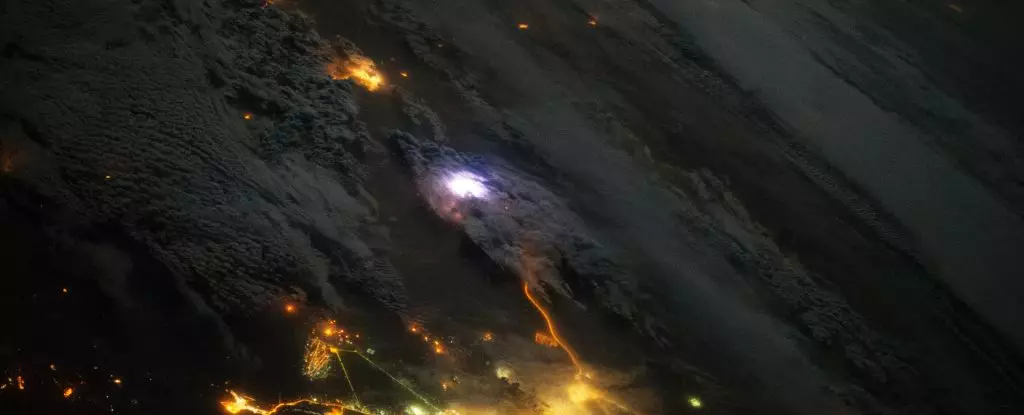Lightning storms are dramatic displays of nature’s power, illuminating the sky with bursts of electricity and roiling thunder. While their visceral beauty captivates many, recent research reveals a profound connection that extends beyond our atmosphere. Lightning does not merely affect the terrestrial environment; it also influences the very fabric of space weather, unleashing powerful electrons—often referred to as “killer” electrons—into the Earth’s radiation belts. Understanding this phenomenon is not only fascinating but also critical for protecting our satellite infrastructure and human exploration in space.
To comprehend the impact of lightning on space weather, one must first grasp the significance of the Van Allen radiation belts. These two distinct zones, composed of charged particles trapped by Earth’s magnetic field, encircle our planet like a protective halo. The inner belt is located approximately 640 to 9,600 kilometers above the surface, while the outer belt extends from 13,500 to 58,000 kilometers. These belts serve as a buffer against the harmful solar wind—a stream of charged particles emitted by the Sun—thus safeguarding Earth from potential damage.
However, not all particles remain confined within these layers. Within this framework, “killer” electrons can emerge as a formidable threat due to their near-light-speed velocities and extraordinary energy levels. These particles can penetrate the metal of satellites and are even capable of ionizing circuit boards. The detrimental effect of these electrons extends into human health, as exposure to such radiation poses severe risks for astronauts stationed in low Earth orbit.
Lightning and Its Unexpected Role
Recent studies have unveiled an unexpected link between the electrifying phenomena of lightning and the high-energy electrons generated in space. Researchers, led by aerospace engineer Max Feinland from the University of Colorado, Boulder, examined satellite data that revealed clusters of killer electrons traversing the Earth’s inner radiation belt. This revelation challenged the conventional perception of the inner belt as a stable and predictable environment.
What’s particularly intriguing is the timing of these observations; some surges of high-energy electrons were recorded shortly after lightning occurred. This correlation suggests an intricate mechanism, wherein lightning generates electromagnetic waves known as whistler waves. These waves, traveling through the plasma of the radiation belt, create conditions that allow electrons to interact. Lower-energy electrons transfer their energy to higher-energy counterparts, culminating in the generation of relativistic killer electrons.
The role of whistler waves in this electromagnetic dance cannot be overstated. These waves are low-frequency radio waves produced during lightning strikes, causing perturbations in the surrounding plasma. Feinland’s analysis indicates that these waves might be flattening the inner radiation belt and generating surges of killer electrons that oscillate back and forth between the magnetic poles of the Earth.
Understanding this phenomenon is still in its infancy. While it is clear that lightning contributes to the formation of these high-energy electrons, the precise conditions required for this interaction remain uncertain. Factors such as solar activity, plasma density, and wave behavior must be studied further to delineate the various mechanisms at play.
The findings from this research hold substantial implications for how we approach space missions, especially those involving humans. If lightning storms can potentially inject high-energy particles into the radiation environment that astronauts must navigate, it raises significant concerns for space safety. The unpredictable nature of these “electron rainstorms” means that timing becomes critical in planning missions that may coincide with elevated lightning activity.
As we explore the cosmos and aim to establish a human presence beyond Earth, our understanding must evolve. Future studies focused on examining the correlations between lightning and its effects on Earth’s radiation belts will be essential. The more we learn, the better we can design protective measures for our technology and astronauts alike.
Lightning storms, while a spectacle of terrestrial power, have deeper implications that stretch far into the realms of space. They serve as a reminder of the interconnectedness of Earth’s atmospheric phenomena and the vast expanse beyond our planet. As scientists continue to unravel the complex relationship between lightning and space weather, it becomes increasingly clear that ongoing research will not only enhance our understanding of nature but also fortify our technological framework against its more dangerous aspects. Thus, the next time a storm rumbles overhead, it may very well be a reminder of the invisible echoes it sends racing into the cosmos.

